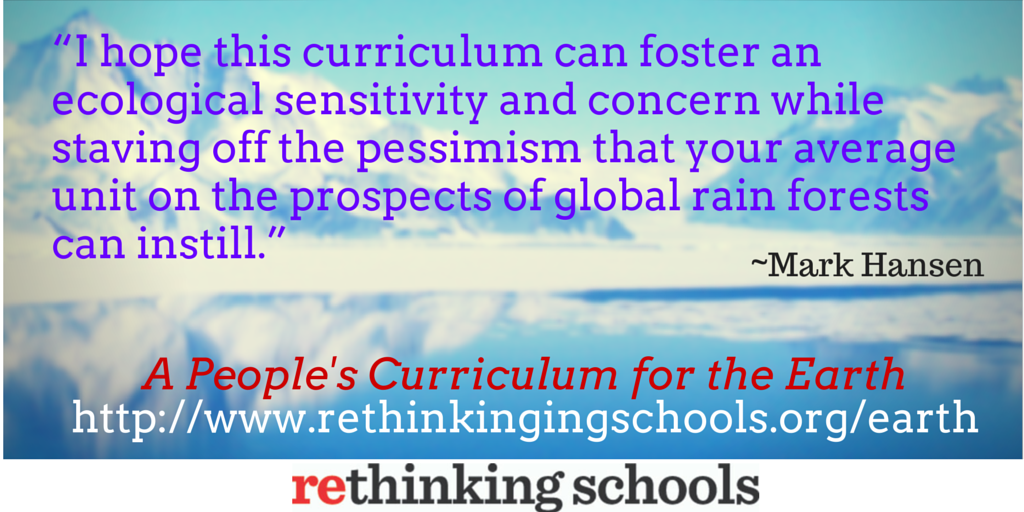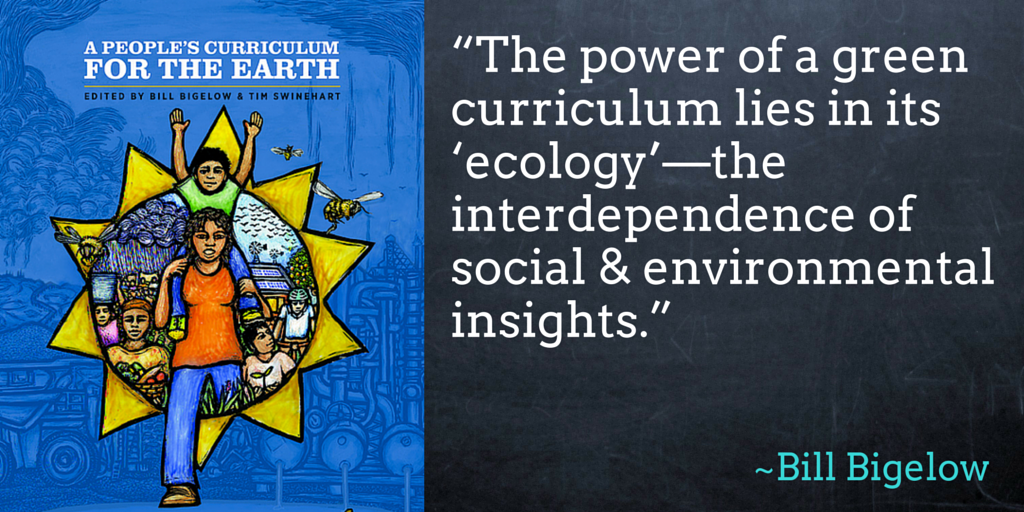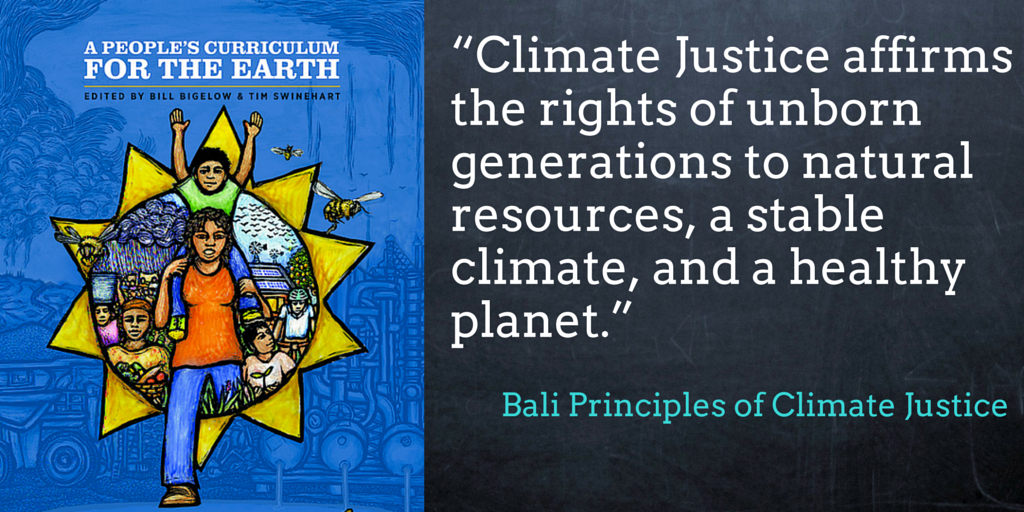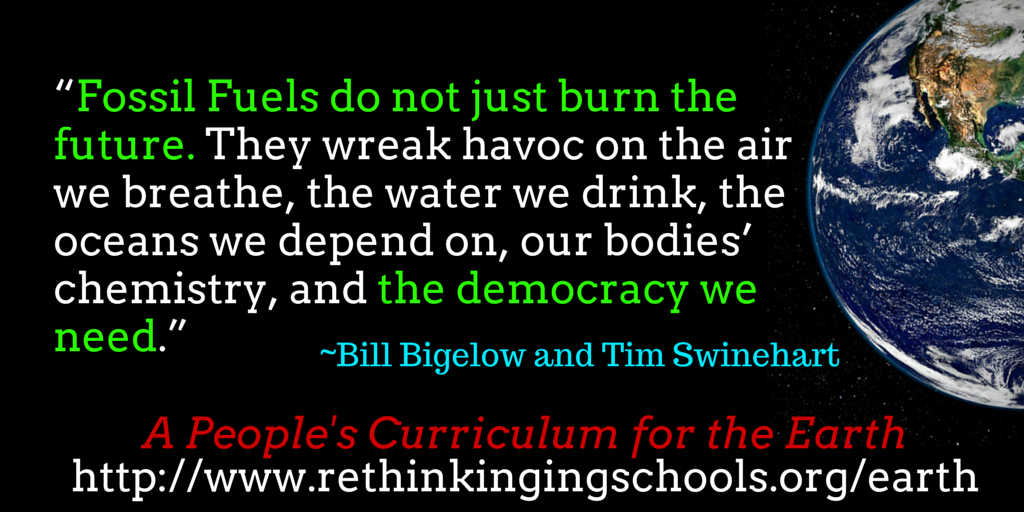Introduction to A People’s Curriculum for the Earth
Edited by Bill Bigelow and Tim Swinehart
It’s hard to say where the idea for this book originated. It may have been in 2007 when we looked at Modern World History, the new global studies textbook our school district, in Portland, Oregon, purchased. The book began one of its three miserable paragraphs on the climate crisis with the statement: “Not all scientists agree with the theory of the greenhouse effect.” And it was buried on page 679. This was the best that Portland could offer its high school students? (This widely adopted book, published by Holt McDougal, still anchors the official curriculum for Portland high school students’ sole class on today’s world.)
Or this book’s origins may have been at an excellent teach-in sponsored by the International Forum on Globalization in Washington, D.C., that same year, called “Confronting the Triple Crisis,” about climate change, the end of cheap energy, and resource depletion and extinction. A number of the contributors to this book presented at this extraordinary gathering: Vandana Shiva, Frances Moore Lappé, Bill McKibben, Michael Klare, and Jeff Goodell. We came away from that weekend convinced of the enormity of the crisis, but we also understood how each supposedly distinct crisis linked to all the others, and then tied back to the fundamental problem of a global economy driven by the quest for profit. The teach-in was our introduction to Annie Leonard’s short film The Story of Stuff, which captures many of these connections with humor and common sense.
The decision to launch this book—and how we imagined it—was no doubt heavily influenced by the powerful and interconnected analyses offered by the speakers at this teach-in. But we were dismayed that there was no discussion about what this all meant for K-12 education. How should environmental justice movements partner with the educators who work daily with the millions of young people learning their ecological A, B, Cs—or, perhaps too often, not learning them? Implicitly, the conference suggested that this was knowledge to be shared among adults. We left inspired and informed, but weighed down by the immense burden of figuring out how to “story” the environmental crisis through curriculum.
Back home in Portland we initiated what we called an “Earth in Crisis” curriculum group, and invited colleagues to discuss and test out teaching ideas with one another. This collective nurtured many of the activities included in this book, and also identified key themes that weave through the book. One of these is that our curriculum must confront the false dichotomy between the environment and people. It’s a theme that Van Jones addresses directly in his TED Talk on “Plastics and Poverty,” included in Chapter One (p. 4). Jones points out that people were rightly concerned about the damage to living systems in the Gulf of Mexico caused by the BP Oil Spill. But he notes that we often do not seem as concerned when that oil gets to where it is “supposed” to go: for example, to petrochemical plants that dot Cancer Alley between Baton Rouge and New Orleans, where it then poisons the largely poor and African American people who live there. Yes, the “environment” is about polar bears, dolphins, redwood forests, and bees; but it is also about human beings—workers, consumers, families, and community members. We call this book a people’s curriculum for the Earth because we try to keep the focus on the inextricable link between nature and people.
And this suggests another theme that emerged in our Earth in Crisis curriculum work in Portland: Everyone on Earth is affected by the environmental crisis, but we are affected unequally—based on race, class, nationality, or location. This is maddeningly evident with the impact of climate change. Throughout the book we feature stories about individuals and communities—Matthew Gilbert and the Gwich’in (p. 74), Koleo Talaki in Tuvalu (p. 96), Anisur Rahman of Antapara, Bangladesh (p. 98), the Aymara people of Bolivia (p. 137), the Yup’ik teenagers of Kwigillingok, Alaska (p. 143), and too many others to list, whose carbon footprint is virtually non-existent and yet who are among the first to suffer from its ravages. Similar issues of race and class are at play when it comes to exposure to workplace pollutants (“Combating Nail Salon Toxics,” p. 280), lead poisoning of children in urban areas (“Teaching About Toxins,” p. 283), or the pollution from mostly foreign-owned manufacturing plants that blankets poor communities around the world with deadly consequences (“Reading Chilpancingo,” p. 288).
This is not to say that people are not organizing in response to this toxic trespass, in the expression of ecologist Sandra Steingraber. They are. And some of them are featured in these pages: the Milwaukee students who blew the whistle on oil contamination in their neighborhood (p. 67), Maria Gunnoe’s passionate anti- mountaintop removal activism with communities in West Virginia (p. 210), the indigenous people described in Winona LaDuke’s “Uranium Mining, Native Resistance, and the Greener Path” (p. 321)—“resilient in the face of a deep history of genocide and destruction.” But there is a fundamental inequality at the heart of the environmental crisis—one that is central to the articles and teaching activities included in this book.
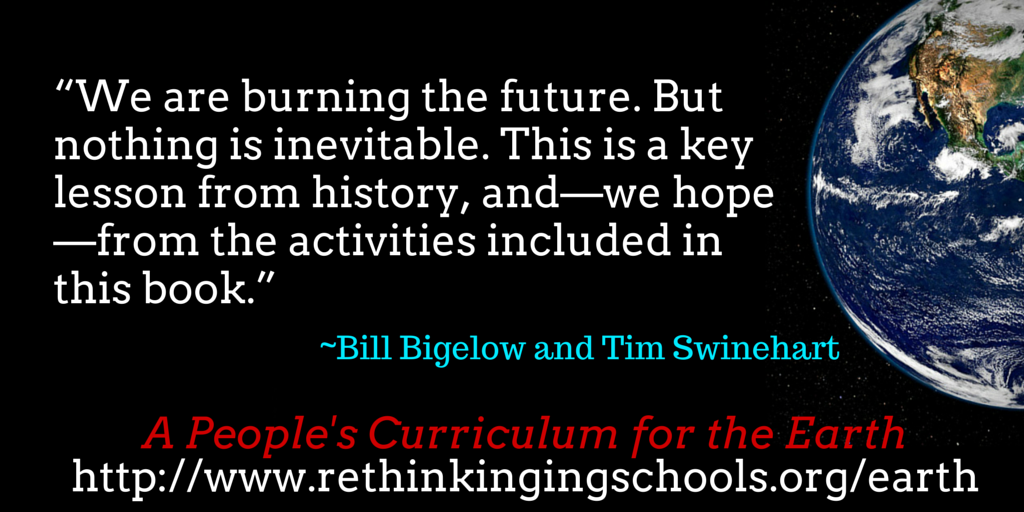 Shorter Showers?
Shorter Showers?
In our “Earth in Crisis” group, teachers kept returning to our students’ responses: They wanted to know what they could do personally. Early in our work, we concluded that we need to help students recognize the inadequacy of responding to the environmental crisis solely as individuals. As we mention in the teaching ideas for Chapter 3, “Facing Climate Chaos” (p. 174), there are entire books that urge students to consider their individual carbon footprints, suggesting that our personal patterns of consumption are a root cause of global warming. Students are urged to think about the frequency of their baths, their electricity use, the stuff they buy. Yes, of course, we want young people— and everyone—to be mindful of the Earth as we go through our daily lives. And we want students to recognize the power they have—collectively or individually—to make the world a better place. But it’s wrong to direct students primarily toward individual solutions to create change.
In his Chapter Five essay, “Forget Shorter Showers,” Derrick Jensen confronts this problematic celebration of individual action:
Consumer culture and the capitalist mindset have taught us to substitute acts of personal consumption (or enlightenment) for organized political resistance. Al Gore’s film An Inconvenient Truth helped raise consciousness about global warming. But did you notice that all of the solutions presented had to do with personal consumption—changing light bulbs, inflating tires, driving half as much—and had nothing to do with shifting power away from corporations, or stopping the growth economy that is destroying the planet? As students’ awareness of the environmental crisis grows, this consciousness can be misdirected by social forces that have an interest in how young people respond. The energy industry would much prefer that our students change their light bulbs, recycle their soda cans, or even install solar panels than organize a demonstration at the state capitol to shut a coal-fired power plant, testify at a public hearing against fracking, or otherwise gum up their fossil fuel machinery.
And there is another way that this celebration of the individual needs to be questioned in a people’s curriculum for the Earth. Individual property “rights” have long been seen as synonymous with “liberty.” “Liberty! Property!” was a cry of the American Revolution. But there were other more democratic cries as well, like Benjamin Franklin’s famous assertion that “Private Property…is a Creature of Society, and is subject to the Calls of that Society, whenever its Necessities shall require it, even to its last Farthing.”
What happens to the Earth if we respect the “right” of the fossil fuel industry to manage their assets however they please? More and more, the headlines are filled with the answer to that question: superstorms, drought, heat waves, melting glaciers, ocean acidification, species extinction, floods, drowning islands. A curriculum on the climate, and the environmental crisis more broadly, needs to address patterns of ownership and decision making. Our curriculum needs to confront the myth that private property is, in fact, private. The fate of the Earth “belongs” to us all.
Capitalism
Helping students acquire a critical consciousness about the environmental crisis means we need to consistently encourage them to ask “Why?” Why is it that the future of life on Earth has been put at risk? It seems an impossible question to answer unless weengage students in thinking about the nature of global capitalism. Throughout the book, we draw students’ attention to this broader systemic context within which the environmental crisis is unfolding. Activities like “The Thingamabob Game” (p. 147) and the trial role play, “Who’s to Blame for the Climate Crisis?” (p. 163), explicitly confront students with the fundamental clash between an economic system that prizes wealth accumulation above all else and people’s need for a healthy environment. Capitalism insists that key productive decisions be made on the basis of what will yield the greatest profit. It grants God-like powers to unelected elites whose livelihoods depend not on creating a world of equality and environmental sustainability, but on making the most money. If we’re going to help our students not just describe, but explain, the environmental crisis, it is essential that educators name this elephant in our classrooms.
Joy amid Crisis
As this book heads to the printer, the Intergovernmental Panel on Climate Change (IPCC) is about to release what news outlets indicate is its most dire report to date—another in a string of reports, each with more urgent language and frightening scenarios than the one before. The new IPCC report warns that at least three-quarters of known fossil fuel reserves must remain in the ground if we are to avoid a 3.6 degree Fahrenheit (2 degree Celsius) rise in global temperatures over pre-industrial times (see “The Mystery of the Three Scary Numbers, p. 180 and “A Matter of Degrees,” p. 192). The consequence of exceeding these limits would “almost certainly have catastrophic effects, including a mass extinction of plants and animals, huge shortfalls in food production, extreme coastal flooding, and many other problems,” according to the New York Times, which received a draft of the report.
The news is bad. But despite the dimensions of the environmental crisis, students can approach this frightening content in ways that are lively and playful. Not long ago, we participated in a weeklong teach-in for 6th through 8th graders about energy issues at Sunnyside Environmental School, a public school here in Portland. Throughout the week, students heard speakers and participated in activities about everything from mountaintop removal coal mining to catastrophic oil spills to the civilization-threatening consequences of climate change. They also encountered people working on solar and wind power, local food initiatives, and other innovative responses to environmental challenges; but the week definitely offered an adult dose of planetary crisis. Nonetheless, in classrooms we visited during the concluding activist projects that students worked on, these middle schoolers were anything but grim; and their small- group work was electric with idea sharing and laughter. As with adults, we’ve found that students are able to live with contradiction; students grasp the sadness and injustice at the heart of the environmental crisis while finding joy and humor. For the book, we’ve selected activities that address key environmental concerns, but these activities do not invite despair. They are engaging, and feature collective work that triggers student playfulness and imagination.
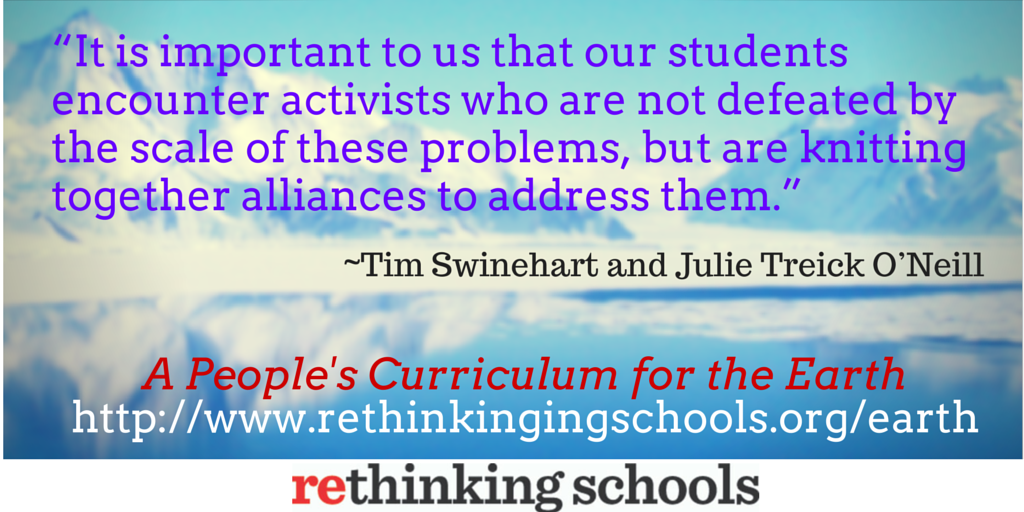
Interconnections
Throughout the final stages of working on this book, we collaborated with Portland teaching colleagues Chris Buehler, Julie Treick O’Neill, and Matt Plies on a role play about La Vía Campesina. Despite the fact that La Vía Campesina may be the largest social movement in the world—with more than 200 million small farmers in its affiliated organizations—it’s pretty much impossible to find its work described in today’s mainstream textbooks. We conclude A People’s Curriculum for the Earth with La Vía Campesina’s efforts because we think that it highlights the way a deep response to any one crisis—for example, how to feed a world populated by perhaps a billion hungry people—addresses other social and environmental crises.
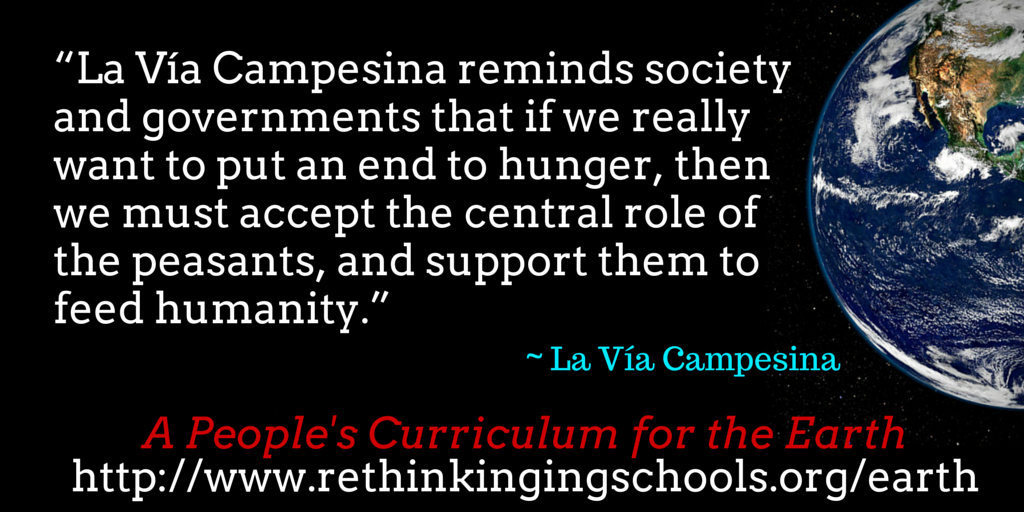
La Vía Campesina’s presents a grassroots, “agroecological” challenge to agribusiness’s globalized, free market, chemical-drenched, genetically modified prescription for the world’s food production. The peasant movement shows that addressing hunger can simultaneously address climate change, inequality, public health, unemployment, forced migration, and much more. These are the kind of interconnections that infuse our curricula with hope— offering students the sense that fundamental change is not only desperately needed but also possible.
Challenging Curricular Apartheid
The teaching we observed at Sunnyside Environmental School showed us what happens when teachers collaborate across disciplines. Unfortunately, in too many schools, the environmental crisis seems to have become a kind of curricular hot potato. No discipline wants to claim the crisis as its own. We get it. We are both high school social studies teachers and we often bump up against our own shaky grasp on scientific concepts, trying to recall details from past biology and chemistry classes. While teaching one climate lesson at Lincoln High School, a student made an assertion about the impact of methane versus carbon dioxide that stumped us both and sent us combing through IPCC reports that evening. We try not to let these moments force us to retreat into the silo that traditionally has been considered social studies. And we’ve spoken with science teachers who feel that analyzing the social causes and effects of climate change reaches beyond their curricula or of their own knowledge. Similarly, teachers in language arts, mathematics, world languages, business, physical education, or art may wonder, “What does this have to do with my class?”
But in this moment of crisis, it’s imperative that we reject artificial barriers between disciplines. Throughout this book we’ve featured stories from educators who consciously cross conventional curricular boundaries—see for example, “Carbon Matters” (p. 110), “Science for the People” (p. 273), “Measuring Water with Justice” (p. 297), and “Facing Cancer” (p. 309). Throughout the curriculum, educators can collaborate to help students become the scientist-activists they need to be. Confronting the toxic injustice that has become one of the defining features of our time requires us immediately to begin constructing a fossil fuel-free world built on principles of ecology and justice, rather than profit and endless growth. No matter which classes we teach, educators need to find ways to help young people develop the analytical tools to understand the causes of the environmental crisis and to exercise their utopian imaginations to consider alternatives.
Political and Educational Context
In an article in the Guardian, Naomi Klein, author of This Changes Everything: Capitalism vs. the Climate, laments the “bad timing” of the climate crisis:
Our problem is that the climate crisis hatched in our laps at a moment in history when political and social conditions were uniquely hostile to a problem of this nature and magnitude—that moment being the tail end of the go-go 80s, the blast-off point for the crusade to spread deregulated capitalism around the world. Climate change is a collective problem demanding collective action the likes of which humanity has never actually accomplished. Yet it entered mainstream consciousness in the midst of an ideological war being waged on the very idea of the collective sphere.
That same war has been waged in the education arena. At the precise moment we need our schools to educate and engage the next generation about the historic global challenges we face, public education is under attack from the same private and corporate interests that have polluted our natural and social environments. Curriculum is being standardized and narrowed to what can be poorly measured by bubble tests. Decisions about what schools should teach and children should learn are being moved away from classrooms and communities to the same politicized bureaucracies and monied interests that are undermining democracy. This too is “bad timing.” At a time when we need an urgent national conversation about how schools and curriculum should address the environmental crisis, we’re being told that the problems we need to focus on are teacher incompetence, government monopoly, and market competition. The reform agenda reflects the same private interests that are moving to shrink public space—interests that have no desire to raise questions that might encourage students to think critically about the roots of the environmental crisis, or to examine society’s unsustainable distribution of wealth and power.
* * *
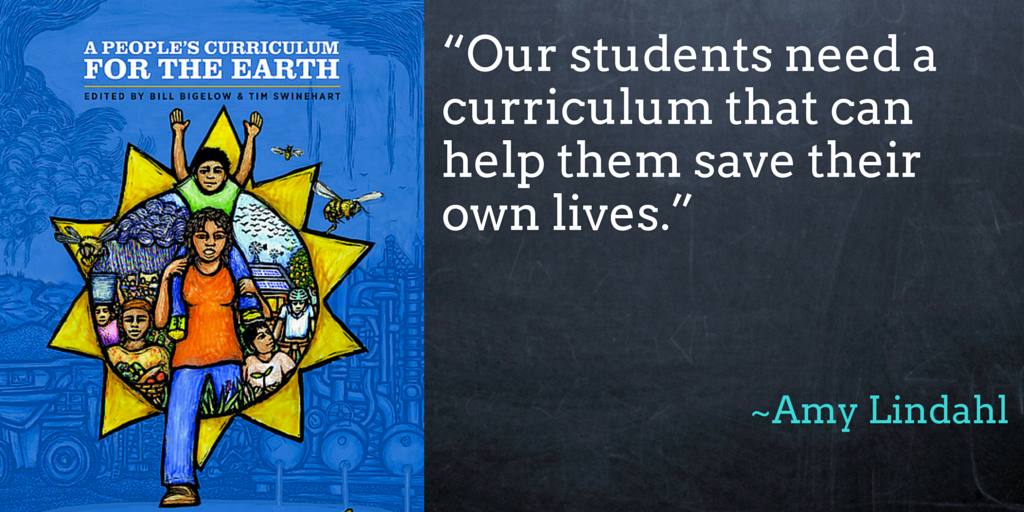
This book is not so much “a people’s curriculum for the Earth” as it is an invitation to begin to build that curriculum. And it’s encouragement to educators to demand the right to effect a curriculum that honestly and deeply addresses the environmental crisis. Some of this work will go on in our classrooms; in meetings with other teachers; in teacher social justice conferences in San Francisco, New York, Milwaukee, Atlanta, Chicago, and Seattle; in our professional organizations; in the pages of Rethinking Schools magazine; and at the Zinn Education Project and This Changes Everything websites. And some will go on in our unions, community organizations, and other activist organizations where we fight to teach about crucial issues in the world.
The intertwined social, economic, and environmental crises that confront humanity require us to be audacious. As Naomi Klein writes, this is “the fight of our lives.” For educators, this is the curriculum work of our lives. And, yes, it is a fight, too. We need to demand and organize for the right to teach about what really matters, and not be forced to toe the textbook line or obey “rigorous” standards, developed afar, that may or may not help students appreciate and act on this moment in history.
We educators need to imagine, cooperate, create, hope—and at times, defy and resist. And we need to see ourselves as part of a broader movement to build the kind of society that is clean and just and equal and democratic. One that seeks to leave the world better than we found it.

